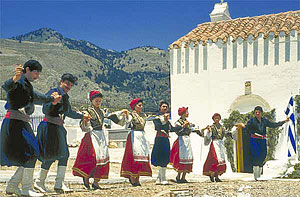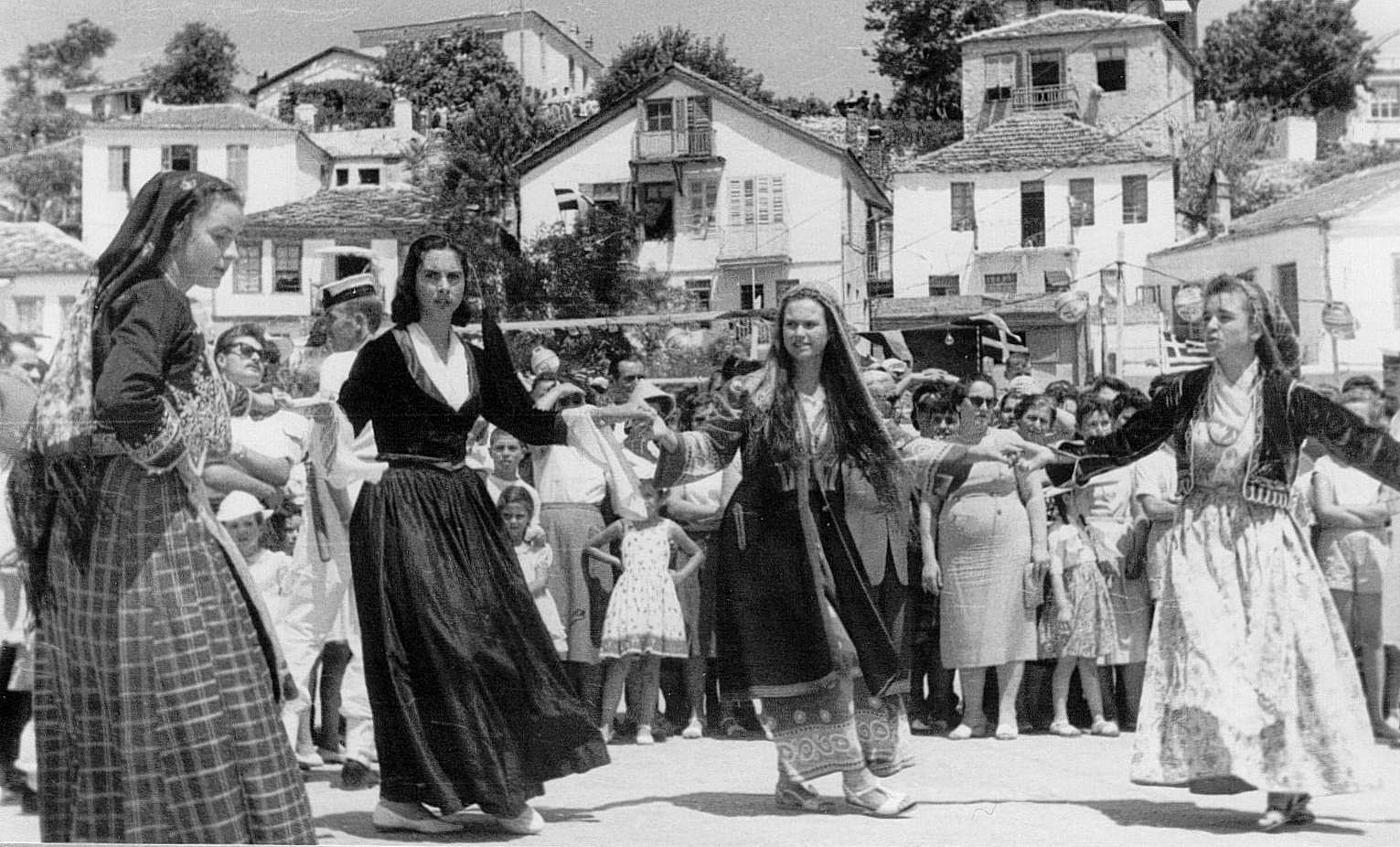|
Koftos
Koftos ( el, Κοφτός) is a lively Greek dance typical of the areas of Thessaly, Epirus and central Greece. "Koftos" in Greek means to cut and the name of the dance comes from the periodic interruptions in the music/tune. When the music stops, the dancers yell "Hey", and you can also put your arms up, down, or clap. This sta dio (two-measure) style dance is a faster syrtos (Syrtos, Sirto, Sirtos), that can also be danced going backwards and forwards or with partners. See also *Greek music *Greek dances *Syrtos *Kalamatianos *Sousta External linksVideo of Koftos being danced*http://voluntocracy.org/Music/Koftos.mid References [...More Info...] [...Related Items...] OR: [Wikipedia] [Google] [Baidu] |
Syrtos
Syrtos ( el, συρτός, ''syrtos'' (also ''sirtos''); plural , ''syrtoi'' (also ''sirtoi''); sometimes called in English using the Greek accusative forms ''syrto'' (also ''sirto''); from the el, links=no, σύρω, ''syro'' (also ''siro''), "to drag he dance) is – in classical and modern Greece – a traditional dance in which the dancers link hands to form a chain or circle, headed by a leader who intermittently breaks away to perform improvised steps. Syrtos, along with its relative kalamatianos, are the most popular dances throughout Greece and Cyprus, and are frequently danced by the Greek diaspora worldwide. They are very popular in social gatherings, weddings and religious festivals. Syrtos and kalamatianos use the same dance steps, but the syrtos is in time and the kalamatianos is in time, organized in a ''slow'' (3 beat), ''quick'' (2 beat), ''quick'' (2 beat) rhythm. Syrtos and kalamatianos are line dances and circle dances, done with the dancers in a ... [...More Info...] [...Related Items...] OR: [Wikipedia] [Google] [Baidu] |
Syrtos
Syrtos ( el, συρτός, ''syrtos'' (also ''sirtos''); plural , ''syrtoi'' (also ''sirtoi''); sometimes called in English using the Greek accusative forms ''syrto'' (also ''sirto''); from the el, links=no, σύρω, ''syro'' (also ''siro''), "to drag he dance) is – in classical and modern Greece – a traditional dance in which the dancers link hands to form a chain or circle, headed by a leader who intermittently breaks away to perform improvised steps. Syrtos, along with its relative kalamatianos, are the most popular dances throughout Greece and Cyprus, and are frequently danced by the Greek diaspora worldwide. They are very popular in social gatherings, weddings and religious festivals. Syrtos and kalamatianos use the same dance steps, but the syrtos is in time and the kalamatianos is in time, organized in a ''slow'' (3 beat), ''quick'' (2 beat), ''quick'' (2 beat) rhythm. Syrtos and kalamatianos are line dances and circle dances, done with the dancers in a ... [...More Info...] [...Related Items...] OR: [Wikipedia] [Google] [Baidu] |
Greek Dance
Greek dance (''choros'') is a very old tradition, being referred to by authors such as Plato, Aristotle, Plutarch and Lucian. There are different styles and interpretations from all of the islands and surrounding mainland areas. Each region formed its own choreography and style to fit in with their own ways. For example, island dances have more of a different smooth flow to them, while Pontic dancing closer to the Black Sea, is very sharp. There are over 10,000 traditional dances that come from all regions of Greece. There are also pan-Hellenic dances, which have been adopted throughout the Greek world. These include specifically the Syrtos, Kalamatianos, Pyrrhichios, Ballos and hasapiko. Traditional Greek dancing has a primarily social function. It brings the community together at key points of the year, such as Easter, the grape harvest or patronal festivals; and at key points in the lives of individuals and families, such as weddings. For this reason, tradition frequently dicta ... [...More Info...] [...Related Items...] OR: [Wikipedia] [Google] [Baidu] |
Greek Dances
Greek dance (''choros'') is a very old tradition, being referred to by authors such as Plato, Aristotle, Plutarch and Lucian. There are different styles and interpretations from all of the islands and surrounding mainland areas. Each region formed its own choreography and style to fit in with their own ways. For example, island dances have more of a different smooth flow to them, while Pontic dancing closer to the Black Sea, is very sharp. There are over 10,000 traditional dances that come from all regions of Greece. There are also pan-Hellenic dances, which have been adopted throughout the Greek world. These include specifically the Syrtos, Kalamatianos, Pyrrhichios, Ballos and hasapiko. Traditional Greek dancing has a primarily social function. It brings the community together at key points of the year, such as Easter, the grape harvest or patronal festivals; and at key points in the lives of individuals and families, such as weddings. For this reason, tradition frequently dict ... [...More Info...] [...Related Items...] OR: [Wikipedia] [Google] [Baidu] |
Thessaly
Thessaly ( el, Θεσσαλία, translit=Thessalía, ; ancient Thessalian: , ) is a traditional geographic and modern administrative region of Greece, comprising most of the ancient region of the same name. Before the Greek Dark Ages, Thessaly was known as Aeolia (, ), and appears thus in Homer's ''Odyssey''. Thessaly became part of the modern Greek state in 1881, after four and a half centuries of Ottoman rule. Since 1987 it has formed one of the country's 13 regions and is further (since the Kallikratis reform of 2011) sub-divided into five regional units and 25 municipalities. The capital of the region is Larissa. Thessaly lies in northern Greece and borders the regions of Macedonia on the north, Epirus on the west, Central Greece on the south, and the Aegean Sea on the east. The Thessaly region also includes the Sporades islands. Name and etymology Thessaly is named after the ''Thessaloi'', an ancient Greek tribe. The meaning of the name of this tribe is unknow ... [...More Info...] [...Related Items...] OR: [Wikipedia] [Google] [Baidu] |
Epirus
sq, Epiri rup, Epiru , native_name_lang = , settlement_type = Historical region , image_map = Epirus antiquus tabula.jpg , map_alt = , map_caption = Map of ancient Epirus by Heinrich Kiepert, 1902 , coordinates = , coor_pinpoint = , coordinates_footnotes = , subdivision_type = Present status , subdivision_name = Divided between Greece and Albania [Baidu] |
Greece
Greece,, or , romanized: ', officially the Hellenic Republic, is a country in Southeast Europe. It is situated on the southern tip of the Balkans, and is located at the crossroads of Europe, Asia, and Africa. Greece shares land borders with Albania to the northwest, North Macedonia and Bulgaria to the north, and Turkey to the northeast. The Aegean Sea lies to the east of the Geography of Greece, mainland, the Ionian Sea to the west, and the Sea of Crete and the Mediterranean Sea to the south. Greece has the longest coastline on the Mediterranean Basin, featuring List of islands of Greece, thousands of islands. The country consists of nine Geographic regions of Greece, traditional geographic regions, and has a population of approximately 10.4 million. Athens is the nation's capital and List of cities and towns in Greece, largest city, followed by Thessaloniki and Patras. Greece is considered the cradle of Western culture, Western civilization, being the birthplace of Athenian ... [...More Info...] [...Related Items...] OR: [Wikipedia] [Google] [Baidu] |
Greek Music
The music of Greece is as diverse and celebrated as its History of Greece, history. Greek music separates into two parts: Greek folk music, Greek traditional music and Byzantine music. These compositions have existed for millennia: they originated in the Byzantine empire, Byzantine period and ancient Greek music, Greek antiquity; there is a continuous development which appears in the language, the rhythm, the structure and the melody. Music is a significant aspect of Greek culture, Hellenic culture, both within Greece and in the Greek diaspora, diaspora. Greek musical history Greek musical history extends far back into ancient Greece, since music was a major part of ancient Greek theater. Later influences from the Roman Empire, Eastern Europe and the Byzantine Empire changed the form and style of Greek music. In the 19th century, opera composers, like Nikolaos Mantzaros (1795–1872), Spyridon Xyndas (1812–1896) and Spyridon Samaras (1861–1917) and symphonists, like Dimitris ... [...More Info...] [...Related Items...] OR: [Wikipedia] [Google] [Baidu] |
Kalamatianos
The Kalamatianós ( el, Καλαματιανός) is one of the best known dances of Greece. It is a popular Greek folkdance throughout Greece, Cyprus and internationally and is often performed at many social gatherings worldwide. As is the case with most Greek folk dances, it is danced in chain with a counterclockwise rotation, the dancers holding hands. It is a joyous and festive dance; its musical beat is , subdivided into of three parts of 3+2+2 beats, corresponding to 3 steps per bar. There are 12 steps in the dance corresponding to 4 bars of music. These steps include 10 steps counterclockwise ("forward") followed by 2 steps clockwise ("backwards"). Depending on the occasion and the dancers' proficiency, certain steps may be taken as jumps or squats. The lead dancer usually holds the second dancer by a handkerchief, this allowing him or her to perform more elaborate steps and acrobatics. The steps of the Kalamatianós are the same as those of the Syrtos, but the l ... [...More Info...] [...Related Items...] OR: [Wikipedia] [Google] [Baidu] |
Sousta
Sousta ( gr, Σούστα, links=no) is a Greek folk dance, performed at weddings as an activity of courtship between husband and wife. It originates from Ancient Greece, and holds prominence in Dodecanese Islands, and broader Aegean region. It is the second most common Greek dance, after the Syrtos, with many Greek islands and villages adopting their own version. The performance of the dance reflects various gender roles, inter-played with values of romance and marriage. The Sousta acted as a socialisation process between the youth of a village, evolving into a dance central to these youth as they grew up and formed relationships with others. Socially, the Sousta also functioned as a visible verification of courtship, namely paying respects to the wife and her family. The Sousta is most commonly performed as a three-step dance, with a 'hopping' motion and crossed-over hands. There are elements of eroticism and courtship acted out in the dance, which is usually performed by pair ... [...More Info...] [...Related Items...] OR: [Wikipedia] [Google] [Baidu] |





